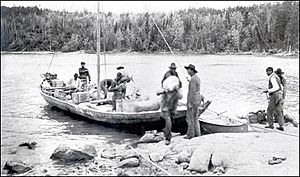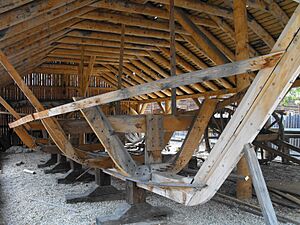York boat facts for kids
The York boat was a special kind of boat used a long time ago in Canada. It was built by the Hudson's Bay Company (HBC) to move furs and other goods across rivers and lakes. These boats traveled through a huge area called Rupert's Land, which stretched from Hudson Bay all the way to the Rocky Mountains.
The boat got its name from York Factory, which was the main office for the HBC. It was designed like a smaller boat called an Orkney yole, which came from the Vikings' longships. There were also slightly different versions of the York boat, like "scows" and "Sturgeon Heads."
The History of York Boats
York boats were much better for carrying cargo than the birchbark canoes used by other companies, like the North West Company. York boats were bigger and could hold more goods. They were also safer when the water was rough.
Why York Boats Were Stronger
These boats were made of heavy wood. This was a big plus when traveling on rivers and lakes where the boat might hit rocks or ice. Canoes, on the other hand, were often made from birch bark or animal hides. These materials could easily tear or get holes.
A strong York boat could just bounce off or slide past obstacles. Things that would badly damage a soft-hulled canoe were not a problem for a York boat.
The Challenge of Portaging
Even though they were strong, York boats had one big problem: they were very heavy. This made them hard to move over land, a process called portaging. When a crew reached rapids or land between waterways, they couldn't just pick up the boat.
Instead, the crew had to cut a path through bushes. Then, they would lay down poplar logs as rollers. Finally, they would drag the heavy boat over the land. This was very hard work!
Life on a York Boat
Working on a York boat was incredibly tough. Sir John Franklin, a famous explorer, once said that the people who chose this life faced "unending toil broken only by the terror of storms." It was a life of constant hard work and danger.
How York Boats Were Built
A typical York boat was about 14 meters (46 feet) long. The biggest ones could carry more than 6 tonnes (13,200 pounds) of cargo. They had a pointed front (bow) and a flat bottom. The back (stern) angled upwards, which made it easier to pull the boat onto shore or launch it.
The boat moved using oars and a large square canvas sail. A long steering pole or a rudder helped guide the boat when sailing. Each boat usually had a crew of six to eight men. The first York boat was built in 1749. By the late 1700s, boat-building stations were all over the region.
The End of an Era
The arrival of the steamboat in the 1800s marked the end for the York boat. Steamboats were faster and could carry even more, making the York boat less necessary.
Traveling the Echimamish River
The Echimamish River was a very narrow river that connected the Nelson River to the Hayes River. This route linked Norway House, Manitoba with York Factory on Hudson Bay. In some parts, the Echimamish River was so narrow that the oars of the York boats would touch the ground on both sides!
The route also included portages around rapids on the Hayes River, some as long as 3 kilometers (1.9 miles). Crews had to haul a 15-meter (49-foot) York boat and up to 12 tonnes (26,400 pounds) of supplies or cargo.
Other Types of Boats: The Columbia Boat
What Was a Columbia Boat?
Boats smaller and lighter than the York boat were made for use in the Columbia District. These were called Columbia boats. They were built on the Columbia River and its smaller rivers. This area had many waterfalls and rapids, so portaging was often needed.
In 1811, an American company started using bateaux (which is just the French word for boat) on the Columbia River. These boats were made from split or sawn cedar wood. When the North West Company took over, they also started using cedar-planked canoes. This was because birch bark, needed for traditional canoes, was not found in the Pacific Northwest.
Descriptions of Columbia Boats
In the 1830s, John Dunn of the Hudson's Bay Company described the Columbia District bateaux. He said they were "made from quarter-inch pine board." They were "thirty-two feet long, and six and a half feet wide in midships." Both ends were sharp, and they had no keel. They were moved with paddles or oars, depending on the river.
U.S. Navy Lieutenant Charles Wilkes visited the Pacific Northwest in 1841. He described Columbia boats as having "great strength and buoyancy." They could carry three tons of weight and had a crew of eight men, plus a leader. They were "thirty feet long and five and a half feet beam." They were sharp at both ends and built with overlapping planks.
These boats had no "knees" (curved supports). Instead, flat oak timbers were bent into shape using steam. They were bolted to a flat keel. The planks were made of cedar and usually ran the whole length of the boat. The top edge (gunwale) was also cedar, but the oarlocks were birch.
A special thing about these boats was that they were only riveted at each end. They were also sealed well with gum. This meant they didn't need many nails. They were perfect for their purpose, light enough to be carried over portages, and easy to fix if damaged.
York Boats Today
York boats are still remembered and celebrated today.
On Television
A York boat was shown in the "Hayes River" episode of the "Great Canadian Rivers" series on TVO in 2001. The show featured a rebuilt boat called the Maryann Muminawatum. It was rowed from Norway House by eight rowers, a coxswain, and a steersman.
In 2002, the Canadian TV show Quest for the Bay also featured a York boat. It showed a journey from Lake Winnipeg to Hudson Bay using one of these boats.
Races and Expeditions
You can still see York boat races in Norway House, Manitoba. Racers compete for a big prize in a celebration called Treaty & York Boat Days.
In June 2011, a group called GeoTourism Canada and Flow North Paddling Company recreated a historical trip. They rowed a 10-meter (33-foot) York boat 538 kilometers (334 miles) on the Peace River. They traveled from Fort Dunvegan to Fort Vermilion.
In 2014, three new York Boats were placed at Lower Fort Garry, a National Historic Site in Manitoba. This was part of a project by Parks Canada to connect with the Metis People.




